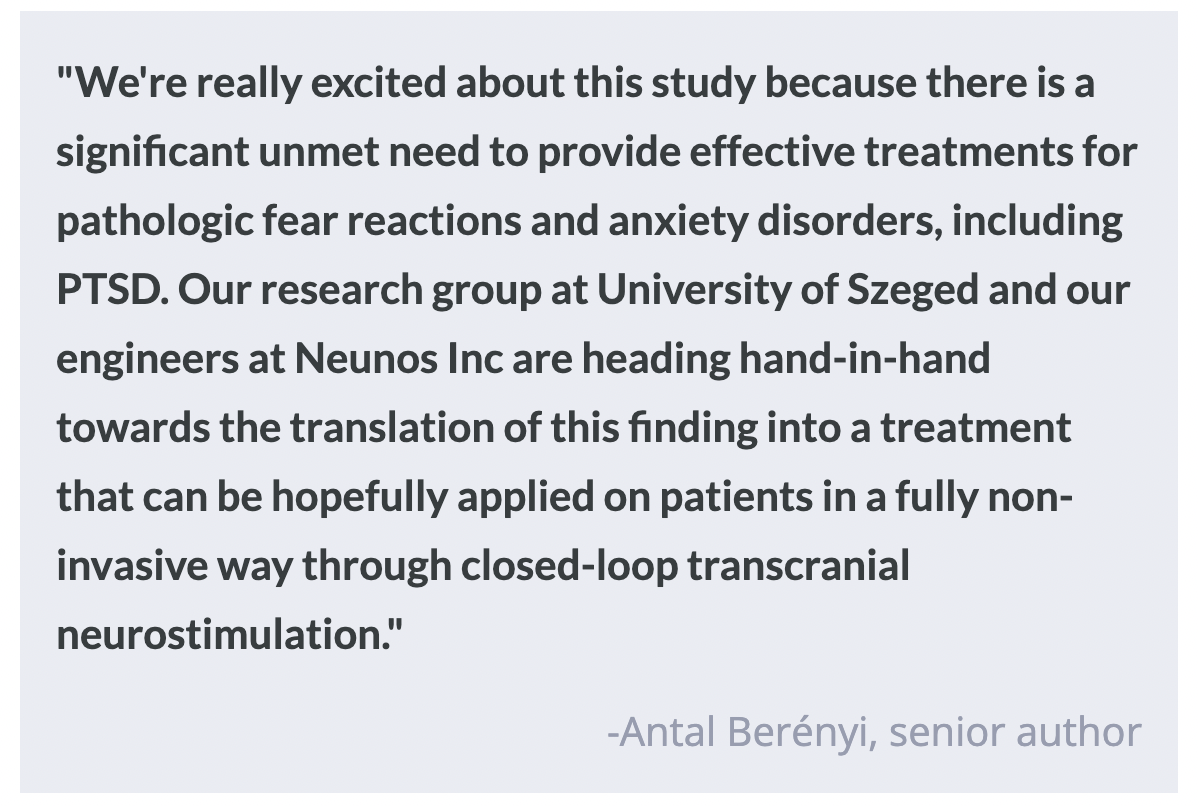Closed-Loop Brain Stimulation Reduces Fear Responses
Post by Laura Maile
The takeaway
Patients with post-traumatic stress disorder (PTSD) have difficulty extinguishing fear responses, which leads to debilitating symptoms. Stimulating the brain’s reward circuitry while brain regions essential in memory consolidation are active can reduce fear.
What's the science?
In PTSD, the brain’s ability to extinguish learned fear responses after removing a threat is diminished. Prior research indicates that the hippocampus and the mesolimbic reward network are important for memory formation and consolidation of fear memories. Closed-loop stimulation, or the automatic stimulation of a brain region when a device detects activity in a specific system, has been shown to enhance memory consolidation when used to activate the reward system. Though the involvement of regions such as the hippocampus, amygdala, and reward centers is known to be important in the maladaptive fear responses present in PTSD, the disease remains resistant to treatment. This week in Nature, Sierra and colleagues used hippocampal activity to initiate closed-loop stimulation of reward circuitry during extinction learning to augment the removal of fear memories.
How did they do it?
The authors utilized fear conditioning to model PTSD in rats, using an auditory tone as the conditioned stimulus paired with foot shocks as the unconditioned stimulus. During extinction learning, animals were placed in a new context and repeatedly presented with the conditioned stimulus without the foot shocks. Animals typically extinguish their fear response after repeated exposure to the conditioned stimulus without the associated foot shock and are considered to be in fear remission once they reduce their freezing to <20% of their initial freezing behavior. The authors used closed-loop stimulation of the medial forebrain bundle (MFB), a white matter tract central to the reward network, in response to hippocampal sharp-wave ripples to activate reward circuits during recall of extinction memories. Some rats received this closed-loop stimulation for one hour following the extinction protocol, while others received open-loop (continuous) stimulation or no stimulation. Persistence of fear reduction was tested by exposing animals to the conditioned stimulus again either 24 hours or 25 days following extinction. The authors then tested whether hippocampal sharp-wave ripples are necessary for fear extinction by silencing them with electrical stimulation of the ventral hippocampus following extinction procedures. Finally, they explored the involvement of Rac1, a protein involved in synapse formation, and dopamine D2 receptors in the basolateral amygdala by infusing a Rac1 inhibitor or a dopamine D2 receptor antagonist following each extinction session preceding the closed-loop stimulation. This allowed them to compare the freezing behavior of animals receiving different treatments during the extinction procedure.
What did they find?
Compared to rats that received open-loop stimulation or no stimulation, rats in the closed-loop stimulation group showed reduced freezing during extinction learning, requiring fewer extinction sessions to achieve fear remission. This means that MFB stimulation in response to hippocampal sharp-wave ripples can help extinguish fear memories faster than controls and that this reduction in fear behavior persists over time. Silencing hippocampal sharp-wave ripples resulted in impaired extinction and increased freezing upon reexposure to the conditioned stimulus. This indicates that the hippocampal sharp-wave ripple activity is required to extinguish fear behavior. Finally, infusing either a Rac1 inhibitor or a dopamine 2 receptor antagonist into the BLA disrupted the closed-loop stimulation-induced improvement in fear extinction. This result suggests Rac1 signaling and dopamine D2 receptor activity in the BLA are involved in fear extinction mediated by neuromodulation of reward circuitry.
What's the impact?
This study found that closed-loop stimulation of MFB reward circuitry in response to hippocampal sharp-wave ripple activity following fear extinction improved the animals’ extinction of fear over time. This means that enhancing the activity of reward circuitry by using biomarkers of memory consolidation as a cue can help animals displaying features of PTSD recover from cued fear conditioning. Deep brain stimulation, which has been successfully implemented in humans with a variety of neuropsychiatric conditions, could be a candidate for improved treatment of PTSD if utilized using the closed-loop design implemented in this study.


